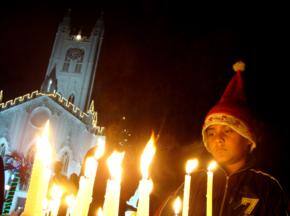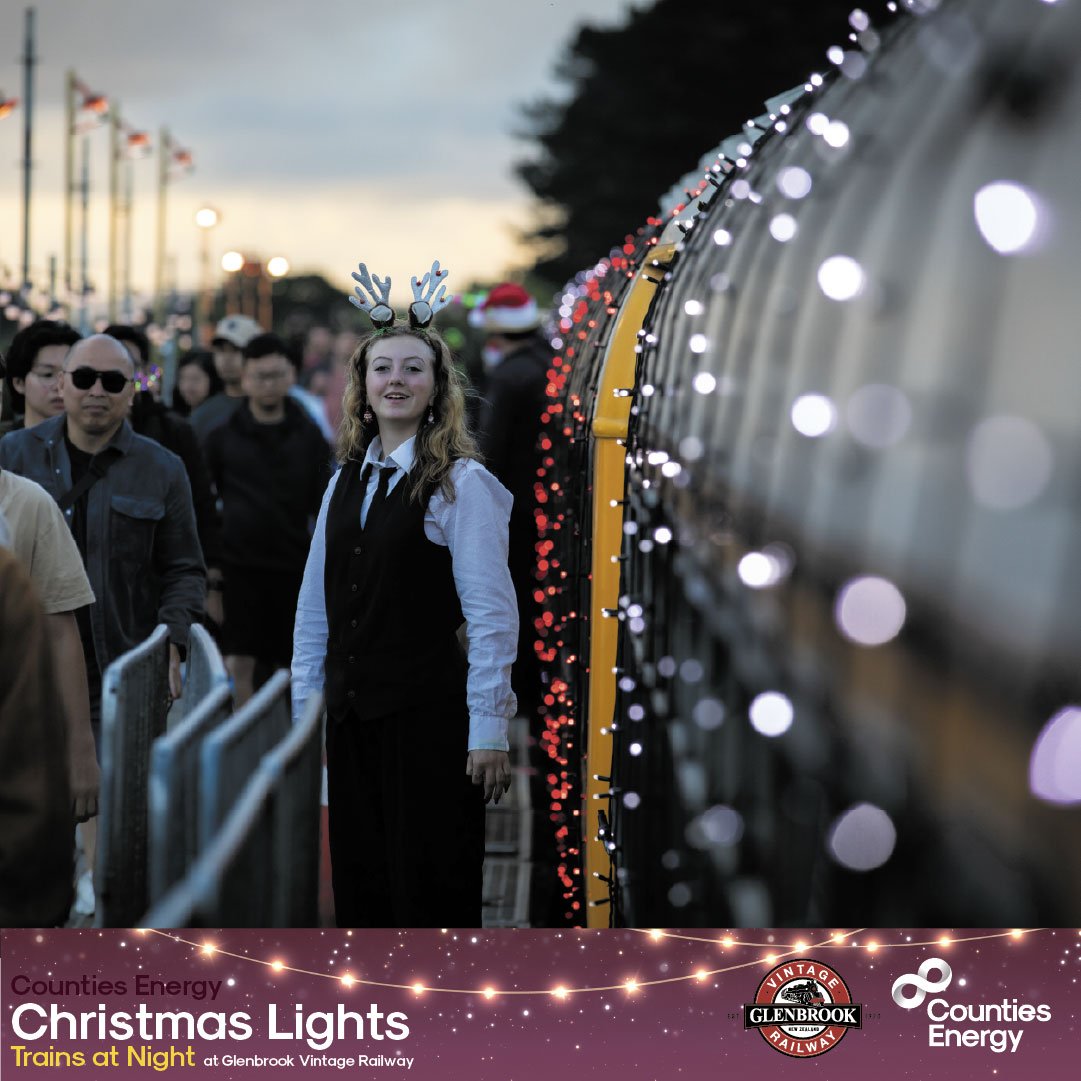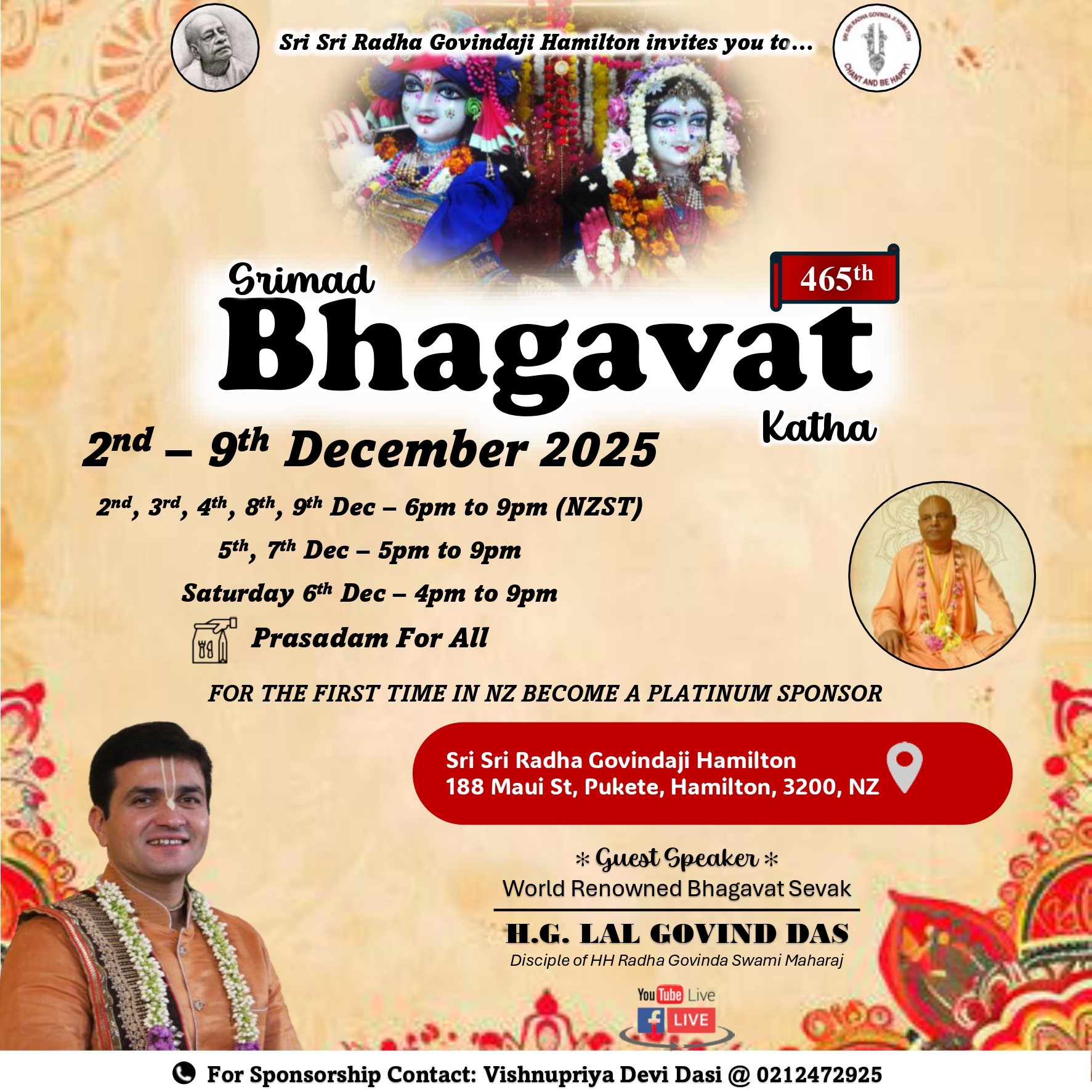Bada Din for all

There is something in the air. You can feel the suppressed excitement. Is it to do with the welcome nip in the air, the tangy smell of orange and the sudden burst of colour on the dusty footpath of Kolkata as the ‘Bhutias’ from the hills of Bhutan spread their woollens? No, something more. Then, dot on 1 December, the rotunda in good old New Market turns into a fairyland with glistening pine trees, paper hats and tinsel baubles. Of course, it’s soon to be “Burra Din” –the big day. That’s how people of Kolkata have lovingly coined a festival from across the seas - Christmas of Santa Claus, mistletoe and plum pudding. So what if the pine trees are fake, or the ‘snow’ is flaky cotton-wool? It’s Christmas after all.
Christmas in Kolkata is something special. Even now when the Sunset Boulevard of the city, i.e. Park Street, is not so brightly illuminated as in olden times and most of the large Anglo Indian community who lent a special sparkle to the festivities have migrated to Australia or Canada, you can feel it. For, by now Christmas has become a festival for all encompassing class and creed.
Unlike in other places, Christmas in Kolkata is not confined to upmarket clubs or expensive hotels and restaurants. The Bengalis love to celebrate the birth of Jesus with good food, outings and picnics. Come Christmas and you can see long queues in front of reputed cake and pastry shops. Now this tradition has spilled over to the ‘para’(small locality) shops. Even the humblest household would like to have a piece of cake on Burra Din.
Reba Mistry is a maid who works in four households a day in the Salt Lake area to make ends meet. But she says, “Buying cake for Christmas day is a must. My son waits for it.”
For once the famous Bengali sweets take a back seat. The confectioners, big and small , gear up for the extra demand from long ahead. These days ‘cake-mixing’ attended by celebs in five-star hotels and restaurants has become quite a thing for photo ops.
However, the old families of the Christian community still stick to their trusted baker in the New Market-Free School Street area for the authentic cake. They buy the dry fruits long ahead, clean them, and keep the ingredients ready to deliver at the baker’s hovel with his old style oven. The cakes are delicious remain fresh for quite a long time.
On the day itself the city’s landmarks, the Alipore Zoo, the grounds of the Victoria Memorial and every open space spill over with visitors enjoying the merry mood and bright sunlight. “Merry Christmas!” you will hear the greeting even from strangers. In the evening of Christmas Eve it is a ‘done’ thing to take a walk in the overcrowded Park Street with family and friends to buy balloons and whistles. Without prior reservation – some do not accept reservation at all, getting a table for a meal is a Herculean task.
True, the special air around Xmas in Kolkata has also to do with heritage and nostalgia. It is a city that flourished under British patronage. Kipling called it “Chance directed, chance created ” as indeed it was three centuries ago. Though there is dispute as to its birth date (not established by the British but that there was already a locality on the banks of the Hooghly), there is no doubt that the development of Calcutta, as it was known before, as a port and later capital of British India, was due to the colonisers. Young, fast growing Kolkata soon offered exuberant fun and frolic to the somewhat conservative British of the day. Accounts by White ladies talk about picnics, river parties, riding rendezvous and fancy dress balls that accompanied the ‘season’ beginning with Christmas.
Indian kings and rich zemindars took to the western-world festivities with great enthusiasm, it seems, from reports. A New Zealand based publication Otago Witness reported (Issue 2285, 16 December 1897) about “The most expensive Christmas card on record” commissioned by the Gaekwar of Baroda to a Kolkata based English firm which was made of pure ivory. Expert carvers worked for six months on the 12x10 card full of intricate designs and studded with 44 diamonds. It was reported to have cost half a million pound sterling at that time. Apparently it was meant for “a certain European lady” but was never delivered to her. But that’s another story.
Even after the capital was shifted to Delhi in 1911, the city retained its reputation for the winter festivities. Rajahs big and small from far corners of the country descended in the city with whole entourages. Whole floors of well known hotels of the day were booked to enjoy the best Christmas east of the Suez. Famous dancers and crooners from abroad landed at the port to perform in the night clubs. Tea planters from the Dooars and Assam, forest officers, colliery owners from Bihar crowded the city. Even the Viceroy used to come down from the capital.
The centre of attraction, as even today, though in a much depleted form, was the Hogg Market or New Market and the “Army and Navy Store” bursting with goodies from across the seas. The liveried ‘Foo Foo’ bands moved from one locality to another while carol singers from the Salvation Army were a common sight, old timers reminisced.
The Bengali zemindars and rich traders vied with each other to prepare the most exclusive ‘dalis’ or ‘dolies’ for the burra sahibs. These gift hampers were piled with sweets, fruits, cakes and toys; sometimes they contained diamond rings and made-to-order Kashmiri shawls.
On the other hand, the sahibs had to ‘Indianise’ some of the rituals too “…the British decorated their bungalows and churches with wreathes of marigolds; for pine boughs they palm branches and for Holly- Poinsettias,” a report says. The entire town from the richest to the humblest used to be agog with preparations for the ‘burra-khana’ on the Christmas day. The talk of the town was, of course, the one at the Viceregal residence at Belvedere which now houses the National Library, a heritage property today. Those who were not invited to the party not included in the ‘who’s who’ list.
Today, the social ‘do’ tradition is faithfully carried on by the premier clubs in the city. Kolkata’s club-culture is famous even today and each rustles up a special menu for Christmas with roast turkey and the traditional pudding, besides other items.
Those days Christmas also meant the beginning of the sporting season. Polo, horse-race and golf hogged the limelight. This tradition still continues.
Today, even as the city celebrates Xmas, it is perhaps inevitable that there are nostalgic moments for older citizens for whom the celebration is not what it was. They wonder aloud where are delicacies like Kulkuls and Rosy cookies gone. The once-famous Christmas lunch at Firpo’s which consisted of “roast turkey and cranberry sauce, mince pies, Christmas pudding, Christmas cake, and first-class wine” has disappeared alongwith the restaurant. Nahoum’s, one of the oldest confectioneries in New Market offered out-of-the world delicacies like coconut luzine, pista cakes and almond samosas. No more; it’s too expensive.
But the infectious mood of Yuletide happiness has a much greater reach today. People irrespective of religion still like to join in the midnight Mass at St. Paul’s Cathedral or pray in the numerous churches. Even non-Christian localities sport Nativity scenes and strings of tuni (tiny) bulbs decorate many a household.
As Neil O’Brien, scion of the Anglo Indian community in Kolkata, says, “Christmas has become much more secular today.”
There is something in the air. You can feel the suppressed excitement. Is it to do with the welcome nip in the air, the tangy smell of orange and the sudden burst of colour on the dusty footpath of Kolkata as the ‘Bhutias’ from the hills of Bhutan spread their woollens? No, something more. Then,...
There is something in the air. You can feel the suppressed excitement. Is it to do with the welcome nip in the air, the tangy smell of orange and the sudden burst of colour on the dusty footpath of Kolkata as the ‘Bhutias’ from the hills of Bhutan spread their woollens? No, something more. Then, dot on 1 December, the rotunda in good old New Market turns into a fairyland with glistening pine trees, paper hats and tinsel baubles. Of course, it’s soon to be “Burra Din” –the big day. That’s how people of Kolkata have lovingly coined a festival from across the seas - Christmas of Santa Claus, mistletoe and plum pudding. So what if the pine trees are fake, or the ‘snow’ is flaky cotton-wool? It’s Christmas after all.
Christmas in Kolkata is something special. Even now when the Sunset Boulevard of the city, i.e. Park Street, is not so brightly illuminated as in olden times and most of the large Anglo Indian community who lent a special sparkle to the festivities have migrated to Australia or Canada, you can feel it. For, by now Christmas has become a festival for all encompassing class and creed.
Unlike in other places, Christmas in Kolkata is not confined to upmarket clubs or expensive hotels and restaurants. The Bengalis love to celebrate the birth of Jesus with good food, outings and picnics. Come Christmas and you can see long queues in front of reputed cake and pastry shops. Now this tradition has spilled over to the ‘para’(small locality) shops. Even the humblest household would like to have a piece of cake on Burra Din.
Reba Mistry is a maid who works in four households a day in the Salt Lake area to make ends meet. But she says, “Buying cake for Christmas day is a must. My son waits for it.”
For once the famous Bengali sweets take a back seat. The confectioners, big and small , gear up for the extra demand from long ahead. These days ‘cake-mixing’ attended by celebs in five-star hotels and restaurants has become quite a thing for photo ops.
However, the old families of the Christian community still stick to their trusted baker in the New Market-Free School Street area for the authentic cake. They buy the dry fruits long ahead, clean them, and keep the ingredients ready to deliver at the baker’s hovel with his old style oven. The cakes are delicious remain fresh for quite a long time.
On the day itself the city’s landmarks, the Alipore Zoo, the grounds of the Victoria Memorial and every open space spill over with visitors enjoying the merry mood and bright sunlight. “Merry Christmas!” you will hear the greeting even from strangers. In the evening of Christmas Eve it is a ‘done’ thing to take a walk in the overcrowded Park Street with family and friends to buy balloons and whistles. Without prior reservation – some do not accept reservation at all, getting a table for a meal is a Herculean task.
True, the special air around Xmas in Kolkata has also to do with heritage and nostalgia. It is a city that flourished under British patronage. Kipling called it “Chance directed, chance created ” as indeed it was three centuries ago. Though there is dispute as to its birth date (not established by the British but that there was already a locality on the banks of the Hooghly), there is no doubt that the development of Calcutta, as it was known before, as a port and later capital of British India, was due to the colonisers. Young, fast growing Kolkata soon offered exuberant fun and frolic to the somewhat conservative British of the day. Accounts by White ladies talk about picnics, river parties, riding rendezvous and fancy dress balls that accompanied the ‘season’ beginning with Christmas.
Indian kings and rich zemindars took to the western-world festivities with great enthusiasm, it seems, from reports. A New Zealand based publication Otago Witness reported (Issue 2285, 16 December 1897) about “The most expensive Christmas card on record” commissioned by the Gaekwar of Baroda to a Kolkata based English firm which was made of pure ivory. Expert carvers worked for six months on the 12x10 card full of intricate designs and studded with 44 diamonds. It was reported to have cost half a million pound sterling at that time. Apparently it was meant for “a certain European lady” but was never delivered to her. But that’s another story.
Even after the capital was shifted to Delhi in 1911, the city retained its reputation for the winter festivities. Rajahs big and small from far corners of the country descended in the city with whole entourages. Whole floors of well known hotels of the day were booked to enjoy the best Christmas east of the Suez. Famous dancers and crooners from abroad landed at the port to perform in the night clubs. Tea planters from the Dooars and Assam, forest officers, colliery owners from Bihar crowded the city. Even the Viceroy used to come down from the capital.
The centre of attraction, as even today, though in a much depleted form, was the Hogg Market or New Market and the “Army and Navy Store” bursting with goodies from across the seas. The liveried ‘Foo Foo’ bands moved from one locality to another while carol singers from the Salvation Army were a common sight, old timers reminisced.
The Bengali zemindars and rich traders vied with each other to prepare the most exclusive ‘dalis’ or ‘dolies’ for the burra sahibs. These gift hampers were piled with sweets, fruits, cakes and toys; sometimes they contained diamond rings and made-to-order Kashmiri shawls.
On the other hand, the sahibs had to ‘Indianise’ some of the rituals too “…the British decorated their bungalows and churches with wreathes of marigolds; for pine boughs they palm branches and for Holly- Poinsettias,” a report says. The entire town from the richest to the humblest used to be agog with preparations for the ‘burra-khana’ on the Christmas day. The talk of the town was, of course, the one at the Viceregal residence at Belvedere which now houses the National Library, a heritage property today. Those who were not invited to the party not included in the ‘who’s who’ list.
Today, the social ‘do’ tradition is faithfully carried on by the premier clubs in the city. Kolkata’s club-culture is famous even today and each rustles up a special menu for Christmas with roast turkey and the traditional pudding, besides other items.
Those days Christmas also meant the beginning of the sporting season. Polo, horse-race and golf hogged the limelight. This tradition still continues.
Today, even as the city celebrates Xmas, it is perhaps inevitable that there are nostalgic moments for older citizens for whom the celebration is not what it was. They wonder aloud where are delicacies like Kulkuls and Rosy cookies gone. The once-famous Christmas lunch at Firpo’s which consisted of “roast turkey and cranberry sauce, mince pies, Christmas pudding, Christmas cake, and first-class wine” has disappeared alongwith the restaurant. Nahoum’s, one of the oldest confectioneries in New Market offered out-of-the world delicacies like coconut luzine, pista cakes and almond samosas. No more; it’s too expensive.
But the infectious mood of Yuletide happiness has a much greater reach today. People irrespective of religion still like to join in the midnight Mass at St. Paul’s Cathedral or pray in the numerous churches. Even non-Christian localities sport Nativity scenes and strings of tuni (tiny) bulbs decorate many a household.
As Neil O’Brien, scion of the Anglo Indian community in Kolkata, says, “Christmas has become much more secular today.”









Leave a Comment